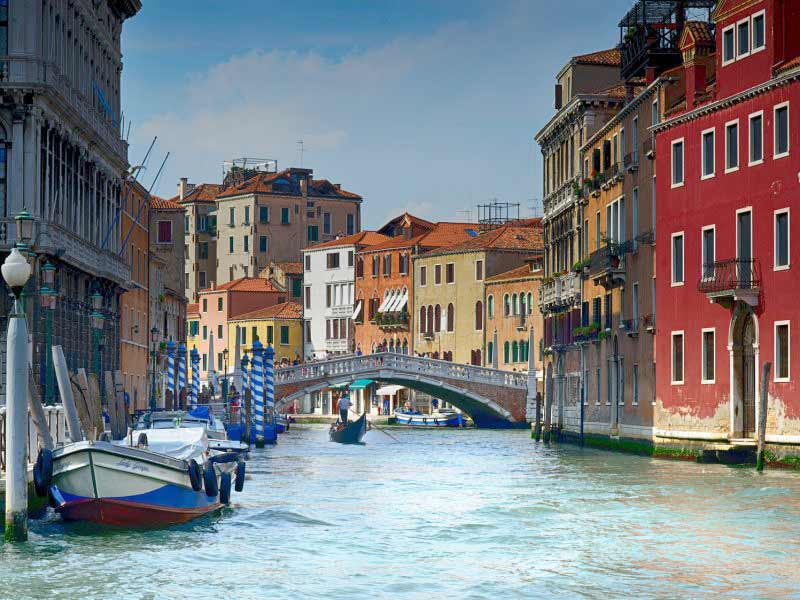History of Venice
According to historians, Venice was founded in 453 AD. Celtic people called the Veneti lived along the coast of what is now North-East Italy, becoming Roman citizens in 49 BC. But when Attila the Hun invaded Italy in 453 AD, some Veneti fled to islands in the lagoon and built a village there, forming a loose federation. When in 568 AD the Lombards invaded the mainland, yet more Veneti ran to the islands swelling the population. At first Venice was controlled by the Byzantine Empire, however in 726 AD, the Venetians partly gained their independence and elected Orso Ipato as doge (their word for duke).
Venice soon flourished as a trading centre and ships sailed to and from its ports. Its population continued to grow steadily. In 1348 AD the Black Death devastated the city, therefore in 1403, Venice introduced quarantine. Ships arriving from infected areas had to stop at an island called Lazaretto and the passengers had to wait for 40 days before they were permitted to enter Venice. A serious blow for Venice came in the form of the discovery of North and South America. This resulted in trade shifting away from the Mediterranean and in 1630 AD the city was struck by plague again. During the 17th century Venice gradually lost power and influence and by 1797 Napoleon dissolved the Republic of Venice.
Getting around Venice
Venice is not a big city and the best way to see it is walking through its streets and alleys, looking at the beautiful canals and the little bridges. There are many ways to get around it if you don’t want to walk: the ‘vaporetto’ (water bus), or water taxi – it’s fast and able to drive you everywhere you want, providing an alternative view of the city. However the most traditional Venetian boat, the Gondola, is hardly the best way to move in the city, but is very romantic and it will provide an unforgettable experience if you do. Be brave and try crossing the Canal Grande by a traghetto you won’t regret it!
Things to do in Venice
Today tourism is the mainstay of Venice. Visitors flock to this canal heavy city for very good reason: Venice is extraordinary, it is magical, and it is worth every penny. Its existence defies logic, ‘La Serenissima’ (Venice’s nickname) is an improbable cityscape of stone palaces that seem to float on water. Cars are banned, every form of transportation floats: from water taxis and vaporetti (the public “bus” ferries) to ambulance speedboats and garbage collectors.
Venice is a city of great art and grand old masters. Venetian painting featured early masters such as the Bellini clan and Jacopo from the 1420s. By the early 1500s, Venice had taken the Renaissance torch from Florence and made it its own. Be warned, when you visit any museums in Venice, they are notorious for changing and extending the opening hours. Before you begin your exploration of Venice’s sights, ask at the tourist office for this season’s list of museum and church opening and closing hours.
Venice’s Newest Bridge – After years of disputes about its utility and design, the Ponte della Costituzione, the fourth bridge spanning the Grand Canal, opened for business in 2008. Venice’s newest bridge is an impressive sight, well worth trekking to.
The Art of the Gondola – Building one of these sleek black boats is an exact science that is still done in the revered traditional manner at boatyards, such as the Squero di San Trovaso . The boats have been painted black since a 16th-century law was passed to restrict the gaudy outlandishness that, at the time, was commonly used to “outdo the Joneses.” Propelled by the strength of a single gondoliere, these boats, unique to Venice, have no modern equipment. They move with no great speed but with unrivalled grace. The right side of the gondola is lower because the gondoliere always stands in the back of the boat on the left. Although some 10,000 of these elegant boats floated on the canals of Venice in the 16th century, today there are only 350. But the job of gondoliere remains a coveted profession, passed down from father to son over the centuries.
The annual masked and costumed Carnevale extravaganza returns to the Lagoon City in January, with the usual roster of exclusive private parties in luxe palazzos, street revelries, costume competitions and colourful folklore. Aim for weekends or end-of-Carnival events for the full, crowded, jamboree atmosphere.
Venice Film Festival – The world’s oldest film festival turns 74 in 2017, and continues to be the kind of inclusive event which draws Venetians and visitors in droves to the Lido to catch the world premieres.
Eating out in Venice
Pasta and pizza are famous the world over, and are the staples generally associated with Italy and its cuisine. The reality, however, is that Italy is home to a variety of cuisines. When visitors come to Venice, many make the mistake of flocking to touristy eateries, eating food that reflects their expectations and not what the Veneziani really eat. With its truly unique lagoon location and proximity to the island gardens of Sant’Erasmo, genuine Venetian cuisine consists of some really flavourful and refined dishes, relying heavily on local fish and vegetables.
Sarde in saor – This delectable agro-dolce or sweet-sour dish, consists of fried sardine fillets marinated in vinegar, onions, raisins and pine nuts. Saor was originally conceived in the Middle Ages, as a method of preservation by Venetian sailors and fishermen. This dish lives on today as a modern day antipasto or appetiser.
Baccala mantecato – A sublime fish-based antipasto. Baccala mantecato (or creamed dried cod) is prepared by soaking, poaching and blending the fish into a smooth mousse, seasoned with olive oil, salt and pepper. Served spread on slices of fresh bread or grilled white polenta.
Risotto al nero di seppia – Rice is a commonly grown staple in the Veneto region, and few dishes are more Venetian than this seafood-based risotto. With the distinct briny flavour of its squid, wine, onion, tomato and ink braise, this dish quickly makes up for the seemingly unpalatable jet-black colour to the rice.
Fegato alla veneziana – Calf liver and stewed onions. The earthiness of the liver is complimented perfectly by the sweet, caramelised onions. This classic dish has been known to convert many a visitor claiming not to like liver. It is often served on a creamy bed of polenta.
Fritole – Only available during Carnavale. Sweet pastry fritters traditionally prepared and eaten as part of the festivities before Lent. Made with a rich batter consisting of flour, eggs, butter, milk, sugar, pine nuts and raisins, they are moulded into balls, deep fried in oil and dusted with sugar.

